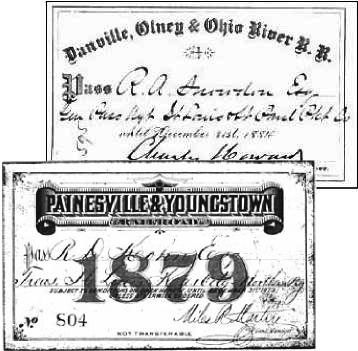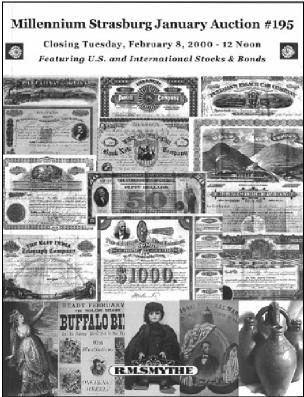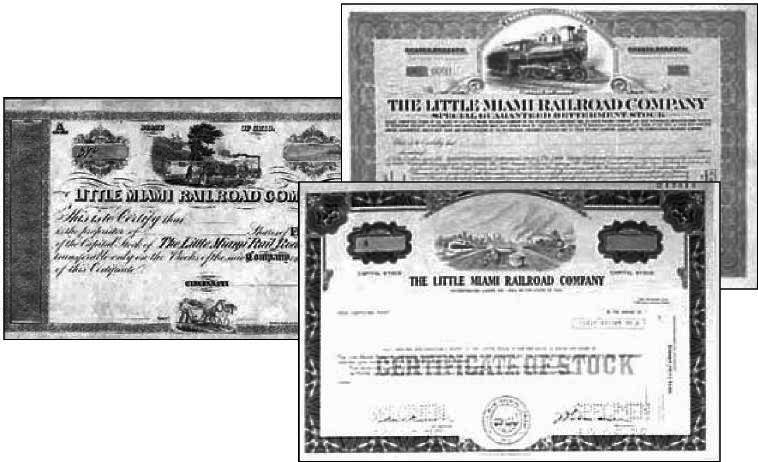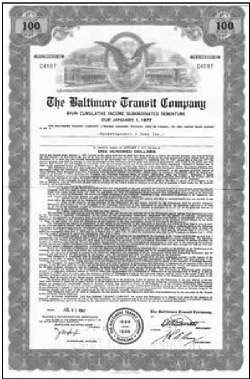
A New Publishing Date
For a variety of reasons, my publisher suggests we should aim for an early 2001 publishing date, instead of the tentative June release we initially wanted.
I have mixed feelings about that. On the one hand, I really want to get this edition out to you. Collectors like you deserve to know all the new items that have been discovered since the first edition.
And I want to get the new edition out because, as you can imagine, I’d like to regain some meager semblance of a life.
On the other hand, I have a huge backlog of certificates to describe and enter. Collectors want to see the new edition as complete as possible. And they have been sending tons of new certificates to make that happen.
From the publisher’s standpoint, BNR Press has other projects in the works, all competing for limited resources. My wife and I (in addition to our regular jobs) own a small bookstore, so I am intimately aware of the realities of publishing schedules and competing projects. It is not all that pretty.
As I put this newsletter “to bed” on June 1, we think that a January, 2001 release date will be the best. And I will try my best (in the limited way an author can affect such things) to solidify that date.
Calculating backwards from that time, I am imagining a couple of tentative deadlines you may participate in:
| Deadline for suggesting additional text subjects |
Jul 1 |
| Deadline for sending catalogs for review |
Aug 1 |
| Deadline for sending certificates for inclusion |
Sep15 |
I like to work well in advance of deadlines. I will not stretch a deadline just to include a few more items. If you have certificates you want me to include, please, please, please send them earlier rather than later. And please do not assume that I have encountered your certificates!!!
Between now and the September newsletter, I will try to make my past newsletters available on www.papermoneyworld.com. Ideally, I would like to use that site to give you more timely information. So, why not check out that website for more accurate scheduling info starting in July?
Almost 3,000 NEW Varieties Since the First Edition!
|
1st Edition |
Currently |
| Number of certificates listed (counting all variants of issued, specimens, etc.) |
8,559 |
12,754 |
| Number of distinct certificates known |
7,152 |
10,133 |
| Number of certificates with celebrity autographs |
699 |
1,010 |
| Number of celebrity autographs known |
232 |
337 |
| Number of railroads and railroad-related companies known |
17,276 |
19,652 |
| Number of companies for which at least one certificate is known |
3,516 |
4,623 |
 Can I talk some adventurous person into a fascinating project? Isn’t there anyone out there who would like to catalog railroad passes and tickets? It is a fascinating field. As much as I would like to do something like this, I have neither the time nor the knowledge. If you’re at all interested, let me know. Maybe I can help you get started.
Can I talk some adventurous person into a fascinating project? Isn’t there anyone out there who would like to catalog railroad passes and tickets? It is a fascinating field. As much as I would like to do something like this, I have neither the time nor the knowledge. If you’re at all interested, let me know. Maybe I can help you get started.
I Recommend Joining the IBSS
In the past few months, I’ve received some tremendous help from members of the International Bond and Share Society. Almost every IBSS newsletter contains something about railroad companies and railroad certificates. I’ve found membership extremely helpful, and I’m sure you will, too. For membership info, contact the IBSS at either PO Box 430, Hackensack, NJ 07602 or membership@scripophily.org. The organization’s web site is www.scripophily.org
Do You Collect Certificates from Companies South of the U.S.?
You may remember me saying that I have a hard time finding information about companies and certificates from Mexico, Central America, and the Caribbean.
Part of the problem is financial. I cannot afford to subscribe to all the auction catalogs published in the U.S. and in Europe. I give grateful thanks to the tiny fraction of catalogers who send me their catalogs for free.
From a monetary standpoint, one year of catalog subscriptions would cost me more than all my royalty income from writing this price guide. Since I lack certain catalogs, I miss many items.
I perceive the second problem to be a limited interest among collectors for Central American certificates. As a consequence, scarce and rare items often get sold in multi-item auction lots and all details are lost.
However, I think the deepest problem is really a very limited amount of material available to collectors. Without a minimum number of collectible certificates to go around, it is hard for collectors to get interested in that part of the hemisphere. Low interest means low prices. If rarity were the only determinant on price, some Central American
certificates would be among the most expensive in the hobby.
I want to improve the information available to collectors on what is out there. To that end, I solicit two types of information: company names and copies of certificates. To show you my need for information, consider that I have over 19,300 U.S. and Canadian railroad and railroad-related companies in my database. All the rest of North America is represented by only 247 companies!
Topography certainly limited rail development, and consequently, the number of companies involved in railroading. So did the early Latin American trend of nationalization. Nonetheless, the diversity of collectible railroad tickets from pre-1920 Mexico suggests the number of railroad companies in that country should be substantially higher than the mere 211 companies I have in the database. I presume other Central American countries to be similar.
Here are my current population statistics:
|
Companies |
Represented
by certs |
| U.S. and Canada |
19,324 |
4,581 |
| Barbados |
1 |
1 |
| Belize |
* |
0 |
| Costa Rica |
2 |
1 |
| Cuba |
18 |
18 |
| Dominican Republic |
0 |
0 |
| El Salvador |
1 |
1 |
| Guatemala |
5 |
4 |
| Haiti |
1 |
0 |
| Honduras |
4 |
4 |
| Jamaica |
3 |
3 |
| Mexico |
211 |
47 |
| Nicaragua |
* |
0 |
| Panama |
1 |
1 |
| Puerto Rica |
1 |
1 |
| St. Christopher |
* |
0 |
* = railroads known, either past or present, but no details
 I have this catalog, but I am missing many you might have. If you write or e-mail, I will send you a current list of every catalog and fixed-price list I have examined so far. All I ask is a chance to see your catalogs and make copies.
I have this catalog, but I am missing many you might have. If you write or e-mail, I will send you a current list of every catalog and fixed-price list I have examined so far. All I ask is a chance to see your catalogs and make copies.
Thanks for the Catalogs
Collectors sent twenty to thirty catalogs this past quarter, including several much-needed German catalogs and Erik Boone catalogs. That reminds me to re-emphasize the point I tried to make in the March newsletter. If you’re not finding anything new, try European sales.
Yes, European prices will be higher than you are used to in the U.S. But here’s a little secret — a lot of rarities are going unsold! Some of my European correspondents are picking up some incredible U.S. pieces, many of which I’ve never seen sold in America. But, even highly experienced European collectors are missing some one-of-a-kind certificates.
Don’t get me wrong. There are actually many, many more rarities appearing in U.S. sales. So many, in fact, that I don’t fully understand how collectors can say they are having trouble finding new certificates. What I will say, though, is that many of those extreme rarities are NOT OBVIOUS.
Not meaning to single out any one auction house over
another, I want you to look carefully at non-illustrated and
multi-item auction lots. In every sale I can remember in the
last couple of years, I saw seriously scarce certificates escape attention because they were either not photographed or they were grouped with overly common certificates in
non-illustrated lots of 5, 10, and 20 pieces.
In such settings, I commonly see certificates selling for as little as one-tenth their probable collectible value. Don’t believe me? Mark some imaginary bids in your auction catalog. Then check realized prices. See what you could have bought. Realize, though, that such buying opportunities will not last forever.
The Little Miami Railroad
Collectors started sending a ton of Little Miami certificates a year or two ago. So many, in fact, that I thought I was going to scream if I saw another one. (2023 note: VERY FEW certificates contributed during 1998-2000 have reappeared for sale in the intervening years!)
Fortunately, a sufficient number of sub-varieties emerged to keep the search interesting. Additionally, the various certificates showed a clear-cut name change around the turn of the century.
I have no idea whether that name change signaled a re-incorporation or not, but if you have additional information, please let me know. Additionally, if you have certificates that I do not show, please send me a copy. Here is how I currently divide the stock certificates for this company:
| LIT-283a (The) Little Miami Rail Road Co. |
| closed cab loco pulls train r-l on curve |
capital $3,000,000 |
|
S-40 |
| open cab loco pulls one car l-r |
capital $750,000 * |
letter 'A' top corners |
S-20 |
| " |
" |
no letter 'A' |
S-30 |
| " |
capital $3,000,000 |
|
S-50 |
| " |
capital $4,215,000 |
|
S-55 |
| " |
capital $4,713,000 |
|
S-60 |
| LIT-283b The Little Miami Railroad Co |
| open cab loco pulls one car l-r |
capital $8,000,000 |
'18—' |
S-65 |
| " |
no capital printed |
'19—' |
S-70 |
| streamliner diesel and steam train |
|
|
S-75 |
| 4-4-0 loco l-r, special betterment stock |
|
|
S-80 |
* capital value often covered with kraft tape

 Until I can learn of definite rail involvement, I try not to include transit companies. The Baltimore Transit Company did operate streetcars and shows one on this $100 bond from 1957. Other varieties include $odd, $500, and $1000 bonds.
Until I can learn of definite rail involvement, I try not to include transit companies. The Baltimore Transit Company did operate streetcars and shows one on this $100 bond from 1957. Other varieties include $odd, $500, and $1000 bonds.
BAL-941-B-50.
Questionable Companies
Hundreds of companies ran significant rail operations without ‘railway’ or ‘railroad’ in their corporate names. The best examples are lumber companies, some of which operated large rail mileages. Fortunately, there are excellent references to the lumber industry and their rail operations.
On the other hand, railroad references often overlook companies that operated rails for more mundane industries. Bridge companies, terminal companies, and holding companies fall into this category.
Transit companies are also problematic. Transit companies obviously carried passengers and freight, but it is often tough to discover whether they carried them on rails, buses, barges, boats, wagons, coaches, or trucks. Until I have confirming evidence of rail involvement, I do not include certificates from transit companies in the database.
The same goes for holding companies. A collector recently sent a copy of an Ohio certificate from “The A C & Y Company.” It sounds like a holding company derivative of the Akron Canton & Youngstown Railroad. But I do not have confirming evidence. Do you?
I keep a file of questionable certificates and find they fall in two categories. Most have names similar to companies with known railroad operations. The remainder have certificates that show typical railroad themes. For inclusion, I merely need to know is if they had rail operations, owned or leased rolling stock, or were otherwise directly related to railroading. Do you know anything about any of these companies.
| OH |
The A C & Y Co. |
| CAN |
Algoma Consolidated |
| NY |
Allegheny Improvement Holding Co |
| CT |
Bristol Brass & Clock Co |
| IL |
California Improvement Co of Illinois |
| COL |
Colombian National Railway Co Ltd (in current Panama?) |
| PA |
Coraopolis & Neville Island Bridge Co |
| PA? |
Grand Trunk-Pennsylvania Transportation Co |
| CO |
The Grays' Peak Scenic Development Co |
| IL |
The Illinois River Bridge Co of Havana |
| IA |
Iowa Valley Construction Co |
| DE |
The Liquid Air Refrigeration & Power Co |
| DE |
MA Midland Improvement & Construction Co |
| NE |
Nebraska Construction Co |
| PA |
North Western Mining & Exchange Co of Erie, PA |
| PA |
Penn Construction Co |
| PA? |
Pennsylvania-Indiana General Transit Co |
| MO |
Pennsylvania Terminal Warehouse Co of St Louis |
| NJ |
Peoples Rapid Transit Co |
| PA |
Phoenix Construction Co |
| NY |
Port Wentworth Terminal Corp |
| VA? |
Roanoke Machine Works |
| DE |
The Susquehanna Corp |
| NY |
Transit Development Co |
| NJ |
The Trenton & Philadelphia Transportation Co |